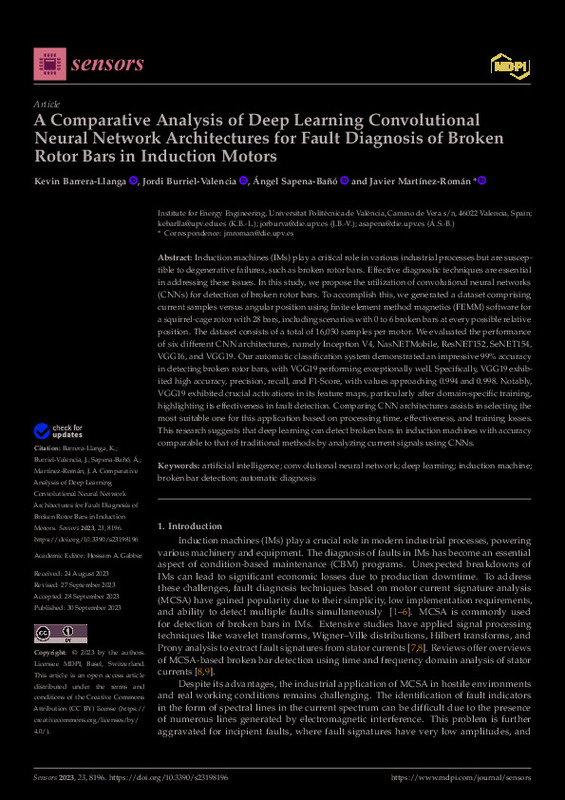JavaScript is disabled for your browser. Some features of this site may not work without it.
Buscar en RiuNet
Listar
Mi cuenta
Estadísticas
Ayuda RiuNet
Admin. UPV
A Comparative Analysis of Deep Learning Convolutional Neural Network Architectures for Fault Diagnosis of Broken Rotor Bars in Induction Motors
Mostrar el registro sencillo del ítem
Ficheros en el ítem
| dc.contributor.author | Barrera-Llanga, Kevin
|
es_ES |
| dc.contributor.author | Burriel-Valencia, Jordi
|
es_ES |
| dc.contributor.author | Sapena-Bano, Angel
|
es_ES |
| dc.contributor.author | Martinez-Roman, Javier
|
es_ES |
| dc.date.accessioned | 2024-01-12T19:01:36Z | |
| dc.date.available | 2024-01-12T19:01:36Z | |
| dc.date.issued | 2023-10 | es_ES |
| dc.identifier.uri | http://hdl.handle.net/10251/201883 | |
| dc.description.abstract | [EN] Induction machines (IMs) play a critical role in various industrial processes but are susceptible to degenerative failures, such as broken rotor bars. Effective diagnostic techniques are essential in addressing these issues. In this study, we propose the utilization of convolutional neural networks (CNNs) for detection of broken rotor bars. To accomplish this, we generated a dataset comprising current samples versus angular position using finite element method magnetics (FEMM) software for a squirrel-cage rotor with 28 bars, including scenarios with 0 to 6 broken bars at every possible relative position. The dataset consists of a total of 16,050 samples per motor. We evaluated the performance of six different CNN architectures, namely Inception V4, NasNETMobile, ResNET152, SeNET154, VGG16, and VGG19. Our automatic classification system demonstrated an impressive 99% accuracy in detecting broken rotor bars, with VGG19 performing exceptionally well. Specifically, VGG19 exhibited high accuracy, precision, recall, and F1-Score, with values approaching 0.994 and 0.998. Notably, VGG19 exhibited crucial activations in its feature maps, particularly after domain-specific training, highlighting its effectiveness in fault detection. Comparing CNN architectures assists in selecting the most suitable one for this application based on processing time, effectiveness, and training losses. This research suggests that deep learning can detect broken bars in induction machines with accuracy comparable to that of traditional methods by analyzing current signals using CNNs. | es_ES |
| dc.description.sponsorship | K Barrera-Llanga appreciates the financial support of the Secretary of Higher Education, Science, Technology and Innovation of Ecuador as a personal sponsor entity. | es_ES |
| dc.language | Inglés | es_ES |
| dc.publisher | MDPI AG | es_ES |
| dc.relation.ispartof | Sensors | es_ES |
| dc.rights | Reconocimiento (by) | es_ES |
| dc.subject | Artificial intelligence | es_ES |
| dc.subject | Convolutional neural network | es_ES |
| dc.subject | Deep learning | es_ES |
| dc.subject | Induction machine | es_ES |
| dc.subject | Broken bar detection | es_ES |
| dc.subject | Automatic diagnosis | es_ES |
| dc.subject.classification | INGENIERIA ELECTRICA | es_ES |
| dc.title | A Comparative Analysis of Deep Learning Convolutional Neural Network Architectures for Fault Diagnosis of Broken Rotor Bars in Induction Motors | es_ES |
| dc.type | Artículo | es_ES |
| dc.identifier.doi | 10.3390/s23198196 | es_ES |
| dc.relation.projectID | info:eu-repo/grantAgreement/AEI//PID2021-128013OB-I00//DESARROLLO DE UNA HERRAMIENTA DE AYUDA AL MANTENIMIENTO PREDICTIVO DE AEROGENERADORES/ | es_ES |
| dc.relation.projectID | info:eu-repo/grantAgreement/GVA//CIAICO%2F2022%2F042/ | es_ES |
| dc.rights.accessRights | Abierto | es_ES |
| dc.contributor.affiliation | Universitat Politècnica de València. Escuela Técnica Superior de Ingenieros Industriales - Escola Tècnica Superior d'Enginyers Industrials | es_ES |
| dc.description.bibliographicCitation | Barrera-Llanga, K.; Burriel-Valencia, J.; Sapena-Bano, A.; Martinez-Roman, J. (2023). A Comparative Analysis of Deep Learning Convolutional Neural Network Architectures for Fault Diagnosis of Broken Rotor Bars in Induction Motors. Sensors. 23(19):1-20. https://doi.org/10.3390/s23198196 | es_ES |
| dc.description.accrualMethod | S | es_ES |
| dc.relation.publisherversion | https://doi.org/10.3390/s23198196 | es_ES |
| dc.description.upvformatpinicio | 1 | es_ES |
| dc.description.upvformatpfin | 20 | es_ES |
| dc.type.version | info:eu-repo/semantics/publishedVersion | es_ES |
| dc.description.volume | 23 | es_ES |
| dc.description.issue | 19 | es_ES |
| dc.identifier.eissn | 1424-8220 | es_ES |
| dc.identifier.pmid | 37837026 | es_ES |
| dc.identifier.pmcid | PMC10575177 | es_ES |
| dc.relation.pasarela | S\504835 | es_ES |
| dc.contributor.funder | Generalitat Valenciana | es_ES |
| dc.contributor.funder | AGENCIA ESTATAL DE INVESTIGACION | es_ES |








